|
|
| home > files |
| Sud,
sud, sud Fabrizio Gallanti |
||||
| In
recent years Chile has lived an astounding development. Having regained
a full democracy at the end of the '80s, Chilean society is tasting
an unprecedented economical expansion, accompanied by radical shifts
in culture and customs. Labeled "the jaguar of South America",
with a clear reference to the so-called Asian tigers, Chile is Latin
America's laboratory of a fast modernization, marked by strong neo-liberal
accents, where the role of the private enterprise is overwhelmingly
stronger than the presence of the state. A rising segment of society has become wealthy in an extremely compressed time, creating a new and vast demand of space: corporate offices, hi-tech compounds, gated communities, new suburban expansions, gigantic shopping malls and myriads of towers of luxury apartments bloom like mushrooms, punctuating the richest sectors of Chile's capital, Santiago. This immense process of transformation has determined a complementary effect that is the augmented demand of good architecture, expressed from a pool of ever-more sophisticated consumers. The inexistence of particularly rigid rules and laws defending the rights of workers, the absence of control concerning security in building and the low prices of materials, work force and land make the dream of building one's own house particularly attractive and feasible. This desire is effortlessly fulfilled by a generation of young architects that has been capable of producing sophisticated and ingenious designs. The domestic small-scale commissions, often holiday houses, constitute a privileged field of typological and formal experimentation, on which to refine formal and technical solutions, creating a language characterized by the eclectic reinterpretation of the legacy of modern architecture. |
[05may2005] | |||
| The
most interesting contemporary Chilean architecture is tensed between
two extremes: an expressive freedom, where heterogeneous references
collide and cohabit within rarefied and elegant compositions and a realist
attitude, which has to adapt formal solutions and details to the local
condition of low technological development. |
||||
 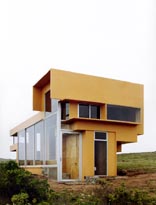 URO1.ORG. House M7. Tunquén, Chile 2004. Photo Juan Alfonso Zapata. |
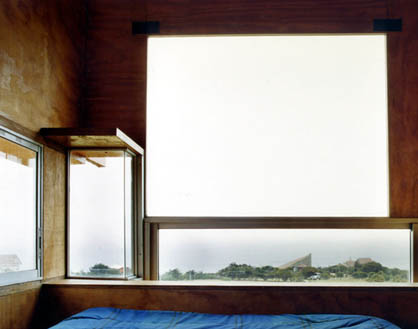 The weekend pavilion in Tunquén designed by the collective group URO1.ORG is a perfect demonstration of the ability of Chilean architects to transcend the difficulties of their practice to reach the powerful expression of an experimental language. 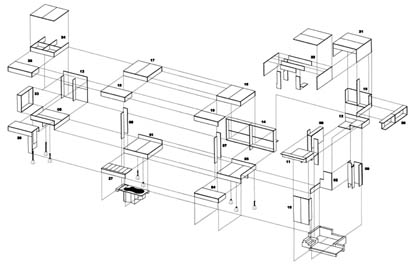 URO1.ORG. House M7. Tunquén, Chile 2004. The tiny house, placed in a dramatic landscape close to the Pacific Ocean, is the result of the assemblage of prefabricated wooden modules, brought to the site by truck. The syncopated accumulation of volumes, reminiscent of the Russian and Dutch constructivists, is the logical consequence of the building system, selected to reduce significantly costs. URO1.ORG is presently designing and patenting a modular element which, used in different combinations, will allow every potential user to realize a customized house: their work implicates a fine questioning of the too-much consolidated roles of architecture and architects. |
|||
  Felipe Assadi with Trinidad Schonthaler. House 20x20. Calera de Tango, Chile 2005. |
 Blue neon tubes used to underline the access of an underground parking; wooden boards applied almost graphically to design the skin of a fruit warehouse, reckoning the piling of fruit-cases; 20 x 20 bathroom ceramic tiles coating a pristine and almost Miesian guest-house are just some of the expressive devices skillfully introduced into his projects by Felipe Assadi. Moving within the self-imposed boundaries of rigorous stereometric compositions, his designs introduce subtle alterations and semantic skids, which wring what at a first glance, might appear as too conformist solutions. Instead the introduction of materials and details not pertaining to construction and architecture defines original while slightly perturbing buildings, where surprise and novelty are always hidden below a crust of apparent simplicity: the swimming pool located on the roof of the Schmitz house (Calera de Tango, 2001) is just one of many twists to rules, which Assadi manages to include skillfully in his projects. |
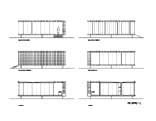 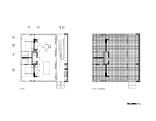 |
||
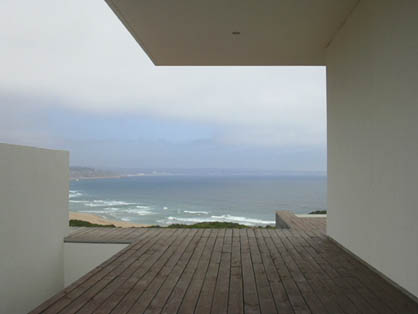 While the taste for the exhibition of the unexpected, even when cheap and humble, characterizes the work of Assadi, it seems that an opposite desire of concealment distinguishes the practice of the office Tidy Arquitectos. Structural efforts and construction processes are hidden behind the smooth and polished surfaces included in the lavish interiors designed by the office. The goal to construct an ethereal and sensual atmosphere, suggesting uses and functions, rather than clearly defining them, is reached through the precise control of light and detailing. Mixing architecture, interior and furniture design, Tidy Arquitectos has set a recognizable style through a remarkable sequence of lounge bars, clubs and restaurants. The same aura of almost ambiguous mystery has been preserved also in the design of some private houses, which set their enigmatic volumes in sharp contrast with the exuberance of Chilean landscape. |
 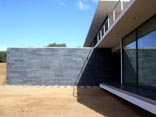 Tidy Arquitectos. House Müller. Tunquén, Chile 2005. |
|||
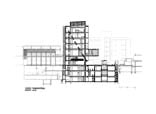   Alejandro Aravena and Fernando Pérez. Medical School, Pontificia Universidad Católica. Santiago, Chile 2004. First floor plan and sections. |
 Alejandro Aravena seems to struggle not to be phagocytized by the demands of a hungry market: in fact through the years he has managed to design almost only public commissions, tracing a perilous and seducing path where high quality design is applied to extremely economic programs. He has put the theme of public housing back into the agenda of international contemporary architecture, through Elemental, a non-profit research unit that organized and managed an international architecture competition, whose winning entries are under process of construction at present. His savvy taste, matching cosmopolite elegance and a deep understanding of the technical and constructive possibilities of the Chilean contexts, has been deployed through a surprisingly diverse array of projects: social housing, educational facilities, performing arts complexes and technological buildings. These four young architects (the older 37) represent the heterogeneous and rich scene of Chilean contemporary architecture, which has reached a sufficient level of maturity to try successfully the jump towards an international stage. Fabrizio Gallanti f.gallanti@gruppoa12.org |
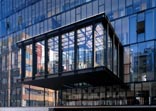 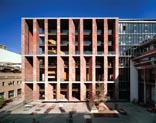 Alejandro Aravena and Fernando Pérez. Medical School, Pontificia Universidad Católica. Santiago, Chile 2004. Photos Roland Halbe. |
||
| This article has been originally written for the Chinese magazine casa international. We thank the author and the magazine for their kind permission to present it on ARCH'IT. | ||||
| >
FELIPE ASSADI |
||||